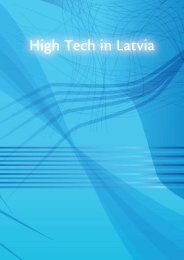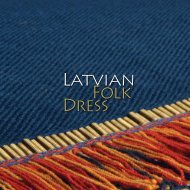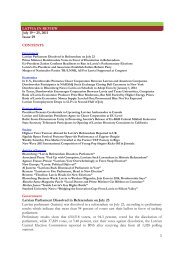PDF National Symbols of Latvia - Latvijas Institūts
PDF National Symbols of Latvia - Latvijas Institūts
PDF National Symbols of Latvia - Latvijas Institūts
You also want an ePaper? Increase the reach of your titles
YUMPU automatically turns print PDFs into web optimized ePapers that Google loves.
The Coat <strong>of</strong> Arms<strong>Latvia</strong>’s national coat <strong>of</strong> arms wasestablished as a symbol <strong>of</strong> independentstatehood after the proclamation <strong>of</strong> anindependent <strong>Latvia</strong>n Republic in 1918. Thecoat <strong>of</strong> arms combines traditional heraldicsymbols <strong>of</strong> <strong>Latvia</strong>n national identity withthose <strong>of</strong> historical territorial districts. Thesun is a central symbol in <strong>Latvia</strong>n culture,particularly in songs, poetry and art, andhere symbolizes <strong>Latvia</strong>n national statehood.Even before achieving independence, astylized sun was used as a national symbolon uniforms worn by the <strong>Latvia</strong>n Rilfemenwho served in the Czarist Russian armyduring World War I. The 17 rays <strong>of</strong> the risingsun represented the 17 <strong>Latvia</strong>n-inhabiteddistricts <strong>of</strong> the Czarist Empire.The three stars above the coat <strong>of</strong> armsrepresent the three historical districts(Vidzeme, Latgale and Kurzeme-Zemgale)which formed a united <strong>Latvia</strong>. Theseculturally important regions are alsosymbolized by historic heraldic figuresthat date back to the early 17th century.The western <strong>Latvia</strong>n regions <strong>of</strong> Kurzemeand Zemgale are represented by a red lion,a symbol used by the Duke <strong>of</strong> Kurzeme(Courland) as early as 1569. <strong>Latvia</strong>’seastern regions <strong>of</strong> Vidzeme and Latgaleare represented by a silver griffin. Thismythological winged creature with aneagle’s head first appeared in 1566 whenthis part <strong>of</strong> <strong>Latvia</strong> came under Polish-Lithuanian control.The <strong>Latvia</strong>n national coat <strong>of</strong> arms wasdesigned by <strong>Latvia</strong>n artist Rihards Zariņš.The proper display <strong>of</strong> the three versions <strong>of</strong>the coat <strong>of</strong> arms - large, small enhanced andsmall - is regulated by <strong>Latvia</strong>n law.The Large Coat <strong>of</strong> ArmsThe large coat <strong>of</strong> arms can be used by the State President, Parliament, PrimeMinister, Cabinet <strong>of</strong> Ministers, government ministries, the Supreme Court andProsecutor General, as well as <strong>Latvia</strong>’s diplomatic and consular missions.The Small Enhanced Coat <strong>of</strong> ArmsThe small enhanced coat <strong>of</strong> arms can be used by agencies <strong>of</strong> the Parliament,Cabinet <strong>of</strong> Ministers and other institutions under direct or indirect supervision<strong>of</strong> the government ministries.The Small Coat <strong>of</strong> ArmsThe small coat <strong>of</strong> arms can be used by other government institutions, municipalauthorities and educational institutions on <strong>of</strong>ficial documents.
The River <strong>of</strong> Destiny – TheDaugavaThe Daugava River is not only <strong>Latvia</strong>’s largest, but alsohistorically most important river. This 375 km riverflows through heart <strong>of</strong> <strong>Latvia</strong> and the center <strong>of</strong> Rīga,serving as a border between the historical and culturalregions <strong>of</strong> Vidzeme and Latgale on the right bank, andKurzeme and Zemgale on the left. Celebrated by poets as‘The River <strong>of</strong> Destiny’, the river was first used by Vikingsas the first leg <strong>of</strong> the Amber Road, a major trade routelinking the lands around the Baltic and Black Seas. Inaddition to its strategic role as a major transport artery,the Daugava was an essential means <strong>of</strong> livelihood for<strong>Latvia</strong>’s inhabitants. In recent times it has become thesite <strong>of</strong> <strong>Latvia</strong>’s hydroelectric power stations and a majorsource <strong>of</strong> energy. The river’s fateful role throughout<strong>Latvia</strong>’s history has made it a treasured subject <strong>of</strong> song,poetry and stories.Symbol <strong>of</strong> Independence –Freedom Monument<strong>Latvia</strong>’s ‘Freedom Monument’, or Brīvības piemineklis,was completed in the nation’s capital <strong>of</strong> Rīga in 1935,and is the single-most important symbol <strong>of</strong> <strong>Latvia</strong>’sindependence and nationhood. Designed by Kārlis Zāleand built entirely from public donations, the monumentsurvived a half century <strong>of</strong> Soviet occupation to emergeas a rallying point for mass pro-independence demonstrationsin the late 1980’s. The sculptural reliefs atthe base <strong>of</strong> the monument depict important moments in<strong>Latvia</strong>’s history, while the woman at the top symbolizes<strong>Latvia</strong>’s freedom and sovereignty. She holds al<strong>of</strong>t threestars symbolizing the three historical districts <strong>of</strong> <strong>Latvia</strong>.The inscription at the base (Tēvzemei un brīvībai) means‘For Fatherland and Freedom’. On holidays and statevisits, flowers are placed at its based to honour all thosewho have sacrificed their lives for <strong>Latvia</strong>.’Jāņi’ – the most <strong>Latvia</strong>nnational holidayIn <strong>Latvia</strong>, celebration <strong>of</strong> the summer solstice is the oldestand most beloved traditional holiday. The two-day longancient pagan midsummer fest begins on Līgo day, June23rd, and concludes on ‘Jāņi ’, June 24th. Most <strong>Latvia</strong>nsleave their residences in the city to gather with family andfriends in the countryside for all-night celebrations. Largebonfires are lit, special foods and beer are prepared, andtraditional midsummer songs and dances are performedto honour the setting and rising <strong>of</strong> the midnight sun.Nature is at its peak in <strong>Latvia</strong> at this time, and lushmeadow flowers, grasses, birch branches and oak leavesare used to festively decorate houses, animals and thecelebrants themselves.






